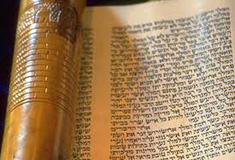The Hidden Dangers of STaM: When STaM Goes Unscrutinized
הרב שי טחןח אלול, תשפד11/09/2024There are many other potential problems that can be found in tefillin. The key point is that each person should ensure their tefillin and mezuzot are free of issues that could invalidate them
תגיות:סתםכשרותאלול
Elul is a time when the poskim recommend checking tefillin and mezuzot(מט״א סימן תקפא ס״י) . Although there is no obligation to check them yearly(או״ח סימן לט ס״י) , it is proper to do so—especially the mezuzot placed outside, which can be damaged by rain and sun(ערוה״ש יו״ד סימן רצא ס״א) .
Let’s summarize what a sofer checks in tefillin, which would mostly also apply to the examination of mezuzot.
The Batim:
In the external check, the sofer examines whether the tefillin boxes are a perfect square. The top part of the bayit must be a complete square, as well as the bottom part, called the titura, and the stitching. While anyone can check for the square shape, a sofer, who regularly inspects tefillin, has a more trained eye to spot potential issues. If anything seems questionable, he will measure it with a caliper. The square can become distorted over time due to weather changes, from humid to cold days, or if a person sweats or wears the tefillin while their hair is wet after a bath.
part of the bayit must be a complete square, as well as the bottom part, called the titura, and the stitching. While anyone can check for the square shape, a sofer, who regularly inspects tefillin, has a more trained eye to spot potential issues. If anything seems questionable, he will measure it with a caliper. The square can become distorted over time due to weather changes, from humid to cold days, or if a person sweats or wears the tefillin while their hair is wet after a bath.
There are other issues that can be detected once the tefillin boxes are opened, such as the lines on the top of the rosh not aligning with the actual separating compartments. Another issue is the presence of glue used during the preparation of the batim to make them appear square, which becomes undetectable after painting. These issues render the tefillin invalid for use, making it extremely important to have them checked regularly.
The Straps:
The sofer also checks the straps to ensure they haven’t lost their black color. If there are white spots, the straps must be repainted or replaced. He also checks for cracks or tears in the straps, which some poskim invalidate, even if they are only slightly torn (בא״ח בעוד יוסף חי וירא אות כג ובמשנ״ב סימן לג ס״ק כט הכשיר אם יש שיעור ברצועה).
It’s also possible that the straps become very narrow in certain places due to constant tightening. If they become less than 10-11 mm wide, they should be replaced immediately. Another common problem is peeling straps, where a layer of latex is attached to the outer surface, which makes them invalid.
The Parshiot:
After the sofer opens the batim, he examines the parshiot—the parchments. This is a very meticulous task that requires extensive knowledge of the laws of safrut and a great deal of patience. Each letter is carefully inspected. What is the sofer checking?
Shape:
Halacha outlines the precise shape of each letter, and the scribe who wrote the parshiot must follow these laws exactly. Since writing the parchments is not easy, mistakes can unfortunately occur and must be examined for their kashrut status. This issue is especially relevant with cheaper parshiot, as the sofer is paid less and must write quickly to make it worthwhile. If a letter is not written correctly, the sofer should stop and decide if it can be corrected. However, many times, due to the pressure to continue, the sofer may move on without fixing it. Once he continues writing, the mistake becomes unfixable, as it is forbidden to correct the letters after further writing has been done.
Due to the pressure of quick writing, many sofrim don’t even take the time to review their work for mistakes. These parshiot are then placed in the batim and sold in Judaica stores. Years later, when the owner of the tefillin decides to have them checked, the sofer often finds numerous mistakes and issues. This scenario is not uncommon. In fact, Rav Moshe Feinstein and Chacham Ovadia both wrote that most STaM sold in the market is not kosher. A sofer who regularly inspects tefillin and mezuzot can attest to how true this is and how flooded the market is with invalid STaM.
This issue is even worse in America, and here’s why. Almost all STaM are prepared in Israel and then sold on the market. When sellers in Israel find a problem or invalidity in tefillin or mezuzot, they return it to the sofer. Now, what is the sofer supposed to do? Another case is when a sofer notices a problem after spending hours writing it. What should he do? He knows that if he sells them, the customer will eventually come back angry after having the parshiot checked and realizing they were sold invalid items.
Of course, if the sofer is yerei shamayim (God-fearing), he should put the invalid items in geniza and not sell them. But unfortunately, some sofrim look for a way to sell them without the risk of the customer returning. One solution they’ve discovered is selling to visitors from the U.S. who come to Israel to buy holy items from a "holy sofer" in the Holy Land. Seeing an American buyer is a golden opportunity since the sofer knows they likely won’t return to Israel to confront him if the items are later found questionable.
Another method is selling these items to merchants who regularly travel to America and supply Judaica stores. Many stores don’t have a certified sofer to check the STaM before placing them on the shelves. When these items are found to be invalid years later by the buyer, it becomes almost impossible to return them to the original sofer, as it’s simply not worthwhile or feasible.
Other issues with the parchments include letters breaking, which can happen due to placing them too tightly in the compartments or because of the way the ink was made.
Another issue with the ink is that it is sometimes very diluted, causing it to appear slightly grayish rather than fully black on the parchment. If the writing is not black, it is not kosher(סימן לב ס״ג) .
Then there are the common problems of two letters touching(סימן לב ס״ד) or a hole in the parchment that existed before the sofer wrote on it(סעיף טז) . Additionally, there can be issues with the tagim (crowns) on the letters, such as many of them being missing(סימן לו ס״ד) or written but not properly attached to the letters, leaving space between the crowns and the letters(משנ״ב ס״ק יג) .
There are many other potential problems that can be found in tefillin, beyond the scope of this article. The key point is that each person should ensure their tefillin and mezuzot are free of issues that could invalidate them. Those with invalid items are not fulfilling this important mitzvah. In the case of mezuzot, they miss out on the Torah's blessing of long life for themselves and their children, as well as protection(דברים יא, כא) , while for tefillin, they are considered sinners and may, because of this, lose their portion in the World to Come(ראש השנה יז, א) .
Let’s summarize what a sofer checks in tefillin, which would mostly also apply to the examination of mezuzot.
The Batim:
In the external check, the sofer examines whether the tefillin boxes are a perfect square. The top

There are other issues that can be detected once the tefillin boxes are opened, such as the lines on the top of the rosh not aligning with the actual separating compartments. Another issue is the presence of glue used during the preparation of the batim to make them appear square, which becomes undetectable after painting. These issues render the tefillin invalid for use, making it extremely important to have them checked regularly.
The Straps:
The sofer also checks the straps to ensure they haven’t lost their black color. If there are white spots, the straps must be repainted or replaced. He also checks for cracks or tears in the straps, which some poskim invalidate, even if they are only slightly torn (בא״ח בעוד יוסף חי וירא אות כג ובמשנ״ב סימן לג ס״ק כט הכשיר אם יש שיעור ברצועה).
It’s also possible that the straps become very narrow in certain places due to constant tightening. If they become less than 10-11 mm wide, they should be replaced immediately. Another common problem is peeling straps, where a layer of latex is attached to the outer surface, which makes them invalid.
The Parshiot:
After the sofer opens the batim, he examines the parshiot—the parchments. This is a very meticulous task that requires extensive knowledge of the laws of safrut and a great deal of patience. Each letter is carefully inspected. What is the sofer checking?
Shape:
Halacha outlines the precise shape of each letter, and the scribe who wrote the parshiot must follow these laws exactly. Since writing the parchments is not easy, mistakes can unfortunately occur and must be examined for their kashrut status. This issue is especially relevant with cheaper parshiot, as the sofer is paid less and must write quickly to make it worthwhile. If a letter is not written correctly, the sofer should stop and decide if it can be corrected. However, many times, due to the pressure to continue, the sofer may move on without fixing it. Once he continues writing, the mistake becomes unfixable, as it is forbidden to correct the letters after further writing has been done.
Due to the pressure of quick writing, many sofrim don’t even take the time to review their work for mistakes. These parshiot are then placed in the batim and sold in Judaica stores. Years later, when the owner of the tefillin decides to have them checked, the sofer often finds numerous mistakes and issues. This scenario is not uncommon. In fact, Rav Moshe Feinstein and Chacham Ovadia both wrote that most STaM sold in the market is not kosher. A sofer who regularly inspects tefillin and mezuzot can attest to how true this is and how flooded the market is with invalid STaM.
This issue is even worse in America, and here’s why. Almost all STaM are prepared in Israel and then sold on the market. When sellers in Israel find a problem or invalidity in tefillin or mezuzot, they return it to the sofer. Now, what is the sofer supposed to do? Another case is when a sofer notices a problem after spending hours writing it. What should he do? He knows that if he sells them, the customer will eventually come back angry after having the parshiot checked and realizing they were sold invalid items.
Of course, if the sofer is yerei shamayim (God-fearing), he should put the invalid items in geniza and not sell them. But unfortunately, some sofrim look for a way to sell them without the risk of the customer returning. One solution they’ve discovered is selling to visitors from the U.S. who come to Israel to buy holy items from a "holy sofer" in the Holy Land. Seeing an American buyer is a golden opportunity since the sofer knows they likely won’t return to Israel to confront him if the items are later found questionable.
Another method is selling these items to merchants who regularly travel to America and supply Judaica stores. Many stores don’t have a certified sofer to check the STaM before placing them on the shelves. When these items are found to be invalid years later by the buyer, it becomes almost impossible to return them to the original sofer, as it’s simply not worthwhile or feasible.
Other issues with the parchments include letters breaking, which can happen due to placing them too tightly in the compartments or because of the way the ink was made.
Another issue with the ink is that it is sometimes very diluted, causing it to appear slightly grayish rather than fully black on the parchment. If the writing is not black, it is not kosher(סימן לב ס״ג) .
Then there are the common problems of two letters touching(סימן לב ס״ד) or a hole in the parchment that existed before the sofer wrote on it(סעיף טז) . Additionally, there can be issues with the tagim (crowns) on the letters, such as many of them being missing(סימן לו ס״ד) or written but not properly attached to the letters, leaving space between the crowns and the letters(משנ״ב ס״ק יג) .
There are many other potential problems that can be found in tefillin, beyond the scope of this article. The key point is that each person should ensure their tefillin and mezuzot are free of issues that could invalidate them. Those with invalid items are not fulfilling this important mitzvah. In the case of mezuzot, they miss out on the Torah's blessing of long life for themselves and their children, as well as protection(דברים יא, כא) , while for tefillin, they are considered sinners and may, because of this, lose their portion in the World to Come(ראש השנה יז, א) .
הוסף תגובה
עוד מהרב שי טחן
עוד בנושא הלכה







